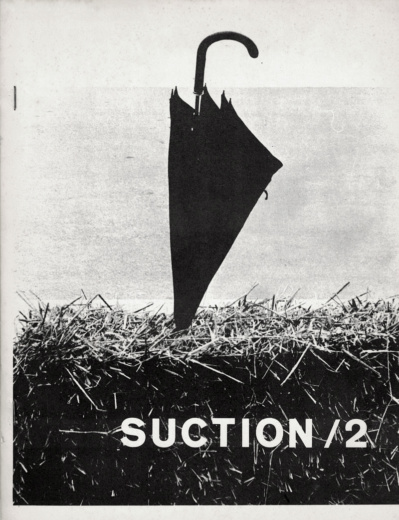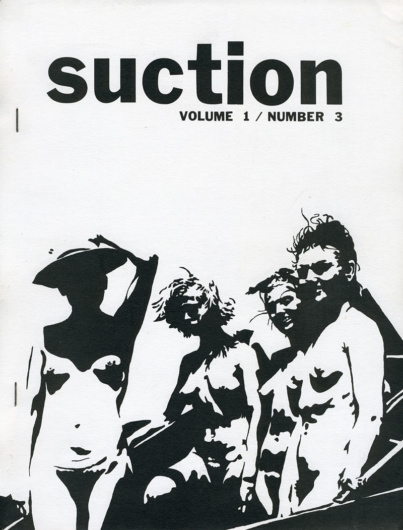Suction: The Magazine of the Actualist Movement
Darrell Gray and Henry Pritchett (1), Darrell Gray (2, 3)
Iowa City
Vol. 1, nos. 1–3 (May 1969–1973).
Subtitle “The Magazine of the Actualist Movement” was added with no. 3.
Suction, vol. 1, no.1 (May 1969).

Despite its rural situation, the Iowa Writers Workshop was a powerhouse in American letters. From Flannery O’Connor to Raymond Carver, many fine fiction writers have attended, and in poetry over eighteen alumni have won the Pulitzer Prize. One particular nexus was seen in the years 1968–73 when Ted Berrigan and Anselm Hollo taught poetry there (Berrigan only briefly) while Harry Duncan ran the Cummington Press from 1956 to 1972, numbering Kim Merker and Allan Kornblum among his students. Carroll Coleman of the Prairie Press was also an active presence on campus (and publisher of a famous spoof book of poetry, Oh Millersville! by Fern Gravel). In the early 1970s there was an explosion of mimeo magazines around the Iowa writers, including Allan Kornblum’s Toothpaste, George Mattingly’s Search for Tomorrow and Dave Morice’s Gum. Darrell Gray (who called himself a “sociopathic realist”) was an active participant in writing and publishing as well as Poets’ Theater, the casual group of players who staged his plays, some of whom (Bob Ernst, David Schein, John O’Keefe) would move to Berkeley from the Iowa Theater Lab and establish the Blake Street Hawkeyes. Darrell Gray is usually referred to as the “Godfather of Actualism,” a spoof literary movement he invented. “We hope to make everything a source of entertainment,” he wrote.
In May 1969 he published the first issue of Suction at 75 cents, with the note, “subscriptions $2 for 4 issues.” The cover is letterpress, probably by Kornblum. The TOC lists seventeen poets, including Ted Berrigan, Anselm Hollo, who also contributes Gunnar Harding translations (Harding, a Swede, was attending Iowa at the time), John Godfrey, Lewis MacAdams, James Tate, Tom Clark, John Clarke, George Mattingly, Aram Saroyan, Dick Gallup, Ray DiPalma, Merrill Gilfillan, and translations of Reverdy and Apollinaire by Jane Delyn. The charming contributors’ notes include “Aram Saroyan: his arm is warm,” “Jane Delyn is feminine, marvelous, and tough.”

Suction, vol. 1, no. 2 (1971). Photograph by Francis Hamit.
Issue 2 (1971) sees the price raised to $1, or $3 for 4 issues. The cover is a photo of an umbrella stuck in a hay bale by Francis Hamit. Mr. Gestetner’s 1881 invention is used for all but the first page: a reproduction of Gary Snyder’s calligraphy in “The Way is not a Way.” To the above roster is added Clark Coolidge, Dave Morice, Jack Marshall, Ramon Fernandez translated by Darrell Gray, Gerard Malanga, Ted Greenwald, Lewis Warsh, and Oger Mou, translated from the Icelandic by Anselm Hollo. It is my belief that Oger Mou was invented by Anselm and that Ramon Fernandez was invented by Darrell. There was a French poet named Ramon Fernandez but the dates and titles (“Where did the Carbon Sleep that it Awoke so Black?”) given here suggest Darrell was riffing off Lorca and other poets. This is a characteristic of his work: sometimes he would come up with a brilliant line, unaware that he had read it in Merwin or another poet, a consequence of his being rarely sober.

Suction: The Magazine of the Actualist Movement, vol. 1, no. 3 (1973). Cover drawing by Steve Shrader.
The third and final issue of Suction appeared in 1973 and is now subtitled “The Magazine of the Actualist Movement,” with an epigraph from W. C. Williams: “Actuality is never frustrated because it is always complete.” The cover is a high-contrast drawing of four nude women by Steve Shrader. In addition to the above we hear from Alice Notley, Steve Toth, Andrei Codrescu, Tom Veitch, Tomaž Šalamun translated from the Yugoslavian by the author and Anselm Hollo, César Vallejo translated by James Stephens, Octavio Paz, and more Ramon Fernandez translated by Darrell Gray. The last three pages are devoted to Joyce Holland, a concrete minimalist poet, who also featured in Gum. This is not the place to discuss Darrell’s sexuality but he enjoyed the female persona so much he hired an actress to appear and perform as his alter ego Joyce Holland, editor of Matchbook, a tiny conceptual magazine the size of a matchbook containing one-word poems.
Starting in Iowa City and continuing for many years in Berkeley—after many of the “Actualists” had actually moved to the Bay Area—the Actualist Convention was a day or weekend-long series of performances: readings, slide shows, films, music, and performances of actual plays. Morty Sklar is writing a book about the Actualist movement.
— Alastair Johnston, Berkeley, April 2017
